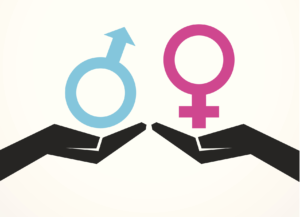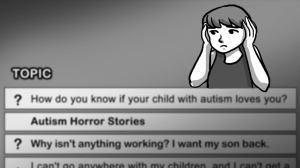
The silhouettes of two hands – one holding a blue “male” symbol, the other holding a dark pink “female” symbol.
If you haven’t noticed, the Transgender Train has definitely left the station. Transgender people are now featured in magazines, television shows, books, websites – you name it. And yet, for some of us, it can start to feel overwhelming.
After all, it’s not like we were taught what any of this gender stuff meant when we were growing up. And it’s true that a lot has changed in a short amount of time. How can we be expected to keep up?
There’s a lot of talk about the transgender community, but if you aren’t in the know, these conversations can feel exclusive or downright confusing.
Are you feeling like you missed the memo? Like you’ve been left behind at the station?
Are you wishing someone would just slow down and explain what all this means?
I get it! People write to me all the time to express these same frustrations – if you feel this way, you’re definitely not alone. Heck, I’m transgender myself and I’m still learning things about gender every single day (I can guarantee you that someone will write to me about this article, teaching me something new!).
That’s why I wanted to create this guide – a guide about transgender people for folks who need it short, simple, and sweet. As short as an entire guide on gender can be, anyway.
Let’s break down the basics of gender, gender identity, and yes, do some much-needed Transgender 101.
The Good Ol’ Gender Binary – And Why It’s Outdated
You’re probably familiar with this story: When a baby is born, the presence of a penis or vulva determines if said child is a boy or a girl.
Boys, on the whole, are expected to be masculine, dress a certain way, and fulfill certain roles in society, like being protectors. Girls, conversely, are expected to be feminine, dress another way, and fulfill other roles in society, like being caregivers.
This is the script we’ve been given for a long time – that our genitals, of all things, determine who we are.
A penis will make someone masculine, which means being tough, active, and strong; a vulva will make someone feminine, which means being nurturing, vulnerable, and passive. When you think about it, it does seem strange that a single body part would assign us such a specific and binary destiny.
…binary? Did I say binary?
I sure did, and you’ll hear me use that word a lot.
The gender binary is created by this script that we’re talking about: That society is made up of men and women who have distinctly different qualities based on, well, what’s going on downstairs.
Based on this binary, we’re given gender roles – kind of like being cast in a play – which tells us what kind of behaviors are acceptable for a person of that gender. It’s reinforced when boys are told not to cry, for example, or girls are encouraged to be “ladylike” and focus on their appearance.
These gender roles vary from culture to culture, and have changed throughout history.
The “gender binary” is limiting at best (is your whole destiny really set from the time you’re born?), and harmful at worst (our genitals determine who we should and should not be?).
I’d like to think people are much more complex than this. It’s far too simplistic to say that our genitals determine what kind of life we should live – or what kind of people we should be.
So why should our genitals determine what kind of gender we should have?
Think fast, I just threw you a curveball! Many of us have been told throughout our lives that being a man or a woman is simply based on our bodies. If that’s not what gender is, what the heck is gender?
I’m glad that you asked. Let’s break it down.
Further Reading:
- The Ultimate Break Down of the Gender Binary – Why It Hurts Us All
- 8 Comics That Remind Us to Throw Out the Gender Binary
What Is Gender? And How Is It Different From Sex?
The most common mistake in defining gender is that it is often confused with sex. Sex at birth refers to the sexual anatomy a person appears to have when they are born (some definitions also include hormones and chromosomes, though those can’t be determined at a glance).
Most people will be assigned female or male at birth based on this biology, but some people will be intersex – meaning that their anatomy, chromosomes, and/or hormones fall outside of typical definitions of female and male.
The important thing to remember is that when we talk about sex, we’re talking about the body (how we, as a society, understand it and choose to define it – bodies are just bodies, after all). When we talk about gender, we’re really talking about how a person individually identifies.
Gender describes the inner relationship a person has to masculinity, femininity, both or neither; how they express themselves based on that relationship; and for some, their relationship to their biological sex.
Yes, I realize that’s a lot of different components. It’s easiest to understand when you break it up into three parts. In this way, gender is kind of like a recipe! Let’s look at the ingredients:
There’s gender identity, which simply means what gender(s) you feel most aligned with (sometimes, this includes what gender roles you feel most comfortable in).
There’s gender expression, which refers to the ways that you “perform” gender (clothing, behavior, hair, etc).
And lastly, there’s something I would call a sex relationship, meaning your feelings about your sex characteristics (am I comfortable having breasts, for example? Am I distressed about having a penis?).
Often times – but not always – our sex relationship is informed by the gender that we are (and vice versa).
The bottom-line is that gender is personal, meaning that each person has their own inner sense of who they are. Gender is something we each determine for ourselves.
In fact, most people, when asked how they knew what their gender was, will often say, “I just knew.” You probably feel the same way. It’s personal – and it’s about much more than our bodies!
Further Reading:
- What’s the Difference Between Sex and Gender?
- Separating Out Gender Identity from Gender Expression
- Science Doesn’t Support the Sex Binary (Pssst: Not Everyone Is Male or Female)
So What Are ‘Transgender’ and ‘Cisgender’ Then?
Traditionally, our society has assigned a gender based upon a person’s biological sex – meaning if you were assigned female at birth (AFAB), you were assumed to be a girl, and if you were assigned male at birth (AMAB), you were assumed to be a boy.
If they assumed correctly – and you identify with the gender they assigned to you at birth – you are called cisgender.
Cisgender is not a bad word or a bad thing. It’s as simple as calling someone tall or short – it just is. It means that you experience your gender as being in line with the one you were assigned.
If they assumed wrong, however – and you identify with a different gender than the one assigned to you at birth – you are called transgender.
For example, I was assigned female at birth, meaning I had the sex characteristics that are referred to as “female.” And because of this, it was assumed that I was a girl.
But when I was looking at my own “gender recipe,” the ingredients made me suspect I wasn’t a girl after all.
I felt that calling myself a woman didn’t resonate with how I felt about myself (identity). I liked to express myself in androgynous and gender ambiguous ways (expression). And I felt very uncomfortable with my breasts and other sexed parts of my body – and I wanted those things to change (sex relationship).
You can probably understand – from my identity, expression, and sex relationship – why I felt more comfortable not identifying myself as a woman… because it didn’t exactly add up for me!
It’s worth noting that there’s no simple or exact formula for gender – because sometimes, our expression, identity, and sex relationship can seem at odds or be very different from one another.
Men can still enjoy feminine clothes (like drag queens, for example, many of whom – but not all – dress up in exaggerated feminine ways to perform, but live and identify as men in their everyday lives). Women can enjoy masculine haircuts. Expression doesn’t always tell us what a person will identify as!
For some people, masculinity and femininity are a very real part of their expression and identity; for others, masculinity and femininity don’t have much relevance. It all depends on the individual, and everyone should be free to express themselves however they feel comfortable!
I also know transgender women (a woman who is assigned male at birth) who have penises and have no problem with having them. I know transgender men who have vulvas and are perfectly content. A sex relationship doesn’t always tell us about a person’s identity, either!
Gender expression and sex relationships, while they may inform how a person identifies, don’t always. You can add basil to tomato soup and it’s still tomato soup!
There are folks who don’t use any of this terminology to describe their gender – whether it just doesn’t fit for them, or they are part of a different culture – and it’s just as valid, too!
Everyone – and their recipes – are unique! It’s always best to not assume and let others declare for themselves what their gender is.
C’mon, Sam! you’re probably thinking. This is so much jargon! Can’t you simplify this for me?
Yes. Let’s keep it simple and sweet: The only thing you need to do is believe people when they share their truth with you, and never assume that you know someone better than they know themselves!
Further Reading:
- 130+ Examples Of Cis Privilege in All Areas of Life For You To Reflect On and Address
- 8 Things Transgender People Do Not Owe You
Are There More Than Two Genders? (Hint: Yes!)
If gender was this socially constructed thing – meaning we created gender roles based on biological sex – who is to say there are just two genders? People, after all, can feel and identify a whole assortment of ways.
There could be as many genders as there are people!
After all, there are so many relationships a person can have to masculinity and femininity (and as you’ll read, both and neither), so many ways we can express ourselves, and countless ways we can feel about our bodies.
It would follow, then, that gender is much more complicated than “man” and “woman.” So if you’re wondering if there could be more than a couple genders, you would be right – there are.
The literature around gender theory is expanding faster than we can keep up with it; there is new vocabulary emerging around gender identity, and the list continues to grow. While indigenous cultures with more than two genders have existed for centuries, Western culture is only now starting to unravel the complexity of gender.
Non-binary, for example, describes people who do not identify as exclusively masculine or feminine.
And this is super cool: There’s a whole list of non-binary identities, some of the most common being agender (not identify with gender at all), genderqueer (an identity or expression that isn’t traditionally masculine or feminine – I identify with this one!), genderfluid (fluidly moving between masculine, feminine, and neutral expressions of gender), and even bigender (identifying with two genders, either alternating or even simultaneously)!
Okay, so I realize that’s a lot of terminology. Take a breath! In, out.
Here’s the takeaway: Our universe of gender is constantly expanding – and I think it’s beautiful that we are uncovering new languages to describe the deepest and most complex parts of who we are!
Why not embrace it?
Further Reading:
- Think You’ve Got ‘Trans’ Down, But Still Feel Confused About ‘Non-Binary?’ Here’s the 101 You’ve Been Looking For
- 10 Myths About Non-Binary People It’s Time to Unlearn
- These 7 Assumptions About Non-Binary Folks May Be Hindering Your Trans Allyship
How Does Sexuality Factor In?
If gender identity, simply put, is what gender a person identifies with, how does sexuality fit into the picture?
Sexuality is who you’re attracted to – which means that transgender people, just like cisgender people, can also be straight, gay, lesbian, bisexual, asexual, queer, and any number of sexualities in-between.
Let’s practice this for a second.
A gay transgender man? He’s a man (who was assigned female at birth) and is attracted to other men.
How about an asexual transgender woman? She’s a woman (who was assigned male at birth) and experiences little to no sexual attraction.
What about a straight transgender man? He’s a man (who was assigned female at birth) and is attracted to women.
What about an agender pansexual person? This is a person who does not identify with any gender, and is attracted to people of all genders.
I know it’s a lot! So here’s the most important part: Gender is not the same as sexuality. Many people mistakenly believe that being transgender is the same as being gay. However, plenty of transgender people are gay, straight, and everything in-between!
Who you’re attracted to is not the same as what gender you identify as. They’re two totally different things!
Just let people disclose their sexuality if and when they feel comfortable doing so – check your assumptions at the door, and always keep an open mind.
Further Reading:
- Gender and Sexuality Labels Are Complicated – And Here’s Why They’re Still Valid
- Do You Know All These Prefixes for Sexual Identities?
Tell Me About This Transition Thing
I could write an entire article on transition alone, but I’ll cover it very briefly here to give you just a taste of what this whole transition thing is about.
Transition is the process of taking one’s internal identity and manifesting it in their life socially, emotionally, or medically.
This can include social transition, which can involve choosing a new name, trying new pronouns (like “he” instead of “she”), changing the way one dresses, coming out to family and friends.
Some transgender people talk about their emotional transition, which was the process of accepting themselves and exploring their identity as an individual.
And lastly, there is medical transition, which can involve hormones and surgeries to physically alter the body.
One common motivation for medical transition is the presence of body dysphoria, which is the distress or discomfort one experiences due to the sexed aspects of their body.
There’s also social dysphoria, which is the distress or discomfort one experiences when they are not gendered correctly in public (when they are a man, for example, that was mistaken for a woman).
Not every transgender person will medically or even socially transition. Not every transgender person even experiences dysphoria! The journey is unique to each and every transgender person, and so, too, are the reasons we pursue our transitions.
Sadly, the media tends to focus on the physical changes transgender people go through without being respectful of our emotional realities and our struggles in society.
That’s why it’s so important for the people in our lives to respect our privacy, and not inquire about our transitions unless we’ve invited them in. Our transitions are personal, and there are much more important things we’re going through and so much more to who we are.
So unless a transgender person has told you they would like to share the details of their transition with you, be sure to keep your questions to yourself. You probably wouldn’t like someone inquiring about YOUR genitals – so maybe don’t do the same to the transgender people in your life!
Further Reading:
- So Your Trans Friend Is Transitioning and You Want to Be Supportive – Here Are 6 Ways How
- 5 Ways to Support a Trans Person Experiencing Body Dysphoria
Okay, I Think I Get It. So Now What?
If you’ve made it to this point, I first want to applaud you. I’ve just condensed seven years of my own research and unlearning – and you just consumed it in, what, less than an hour?
That’s a huge deal! And understandably, there’s a lot to digest. So give yourself a pat on the back for making it through this – believe me when I say that I know just how dense this stuff is.
(It was a total headache just to write it, really…)
The last thing I want to cover is some very basic trans etiquette.
Now obviously, I’ve included additional reading throughout this article – which I hope you’ll bookmark for later! – and a lot of that goes into more detail about the best ways to interact with transgender people.
There’s also a guide over at GLAAD which is a must-read, and it includes a glossary of terms and has some helpful suggestions for allies.
But to start you off, here are some quick and basic guidelines moving forward:
Language: Always use the pronouns that a transgender person requests. If you aren’t sure what they want, ask. Always use the name that a transgender person goes by. If you aren’t sure what they want, ask.
There are no exceptions here – trans people should dictate what they are comfortable with, and cis people should always ask if they don’t know!
Tip: It’s okay if you mess up on someone’s pronouns. Just apologize, correct yourself, and move on!
Questions: It’s okay to ask about our names and our pronouns. But if you want to ask about our transitions, surgeries, bodies, or histories, you’ll have to wait until we bring it up ourselves.
Tip: If you want to know about transgender people, you can always Google your question!
Privacy: Please don’t tell others that we’re transgender, or disclose personal information about our transitions, unless we’ve said it’s okay to do so.
Tip: Sometimes transgender people are “stealth” – meaning the people around them do not know that they are transgender because they are assumed to be cisgender. Others are simply not “out” because they fear the reactions of those around them. Keep this in mind if you are going to talk about a transgender person in your life with others who may not know!
Violence: Sadly, transgender people – especially transgender people of color – can be the victims of harassment and violence at astonishingly high rates. This means that if you see a transgender person who might be in trouble, your intervention can be the difference between life and death!
Tip: Stepping in when we’re being verbally harassed, offering to escort us into the bathroom of our choosing, or simply asking us if we need help when we appear distressed can make more of an impact than you know!
Above all, remember that the internet has an abundance of resources – if you aren’t sure what to do or how to ask, look it up!
Further Reading:
- Trans Etiquette 101: No Offense, But That’s Offensive
- 10 Things You’re Actually Saying When You Ignore Someone’s Gender Pronouns
The Most Important Lesson of All
I remember when I came out to an elderly relative who said to me, “I just don’t understand. I don’t get it. Things were much simpler when I was a kid.”
Maybe you, too, have a younger person in your life who just came out – and all of this feels like a lot to take in.
I’m going to say something that may surprise you: You don’t need to understand.
What? Are you kidding me? you might be saying. I just read this whole guide… and now you tell me that I don’t need to understand any of this?
I’m going to tell you what I told my relative – someone whom I love very dearly.
I looked at her and I said, “One day, we’ll be having dinner. You’ll look across the table at me, and you’ll catch me smiling. And you’ll see something in me – something that’s different. A kind of happiness you’d never seen in me before.”
I smiled at her as she started to tear up. “That’s when you’ll understand. Not because you read a dozen articles and books, not because you saw Laverne Cox on television. You’ll understand because you’ll see how transitioning has made me into the best version of myself, the happiest version of myself.”
If you’re worried about understanding everything there is to know about gender and sexuality, I want you to take a deep breath and remember this:
You will understand what “transgender” really means when you bear witness to a transgender person’s happiness – someone who is finally completely and fully themselves, joyful in their own skin, dazzling. That’s when it’ll all make sense.
I’ve been in rooms filled with transgender people, and I can assure you there is an energy like nothing else – transgender people are resilient, and beautiful, and in many ways, free.
You won’t understand “transgender” just by reading this article. There’s going to be a moment when you do get it, though – looking into the eyes of a loved one, supporting a colleague in transition, sitting beside a friend who’s just started hormones, and feeling the overwhelming energy and joy in the room.
That, my friend, is when everything I’ve said will start to fall into place.
Because at the end of the day, Transgender 101 isn’t about theory. It’s about real people, looking to live out their truth, wherever it might lead them. And when you see it, you’ll just know.
[do_widget id=’text-101′]
Sam Dylan Finch is a Staff Writer and Editorial Coordinator for Everyday Feminism. He is a transgender writer, activist, and educator based in the San Francisco Bay Area, exploring the intersections of mental illness and queerness. In addition to his work at Everyday Feminism, he is also the founder of Let’s Queer Things Up!, his beautifully queer blog. You can learn more about him here and read his articles here. Follow him on Twitter @samdylanfinch.
Many thanks to Robin Tran for her feedback on this piece!
Search our 3000+ articles!
Read our articles about:
Our online racial justice training
Used by hundreds of universities, non-profits, and businesses.
Click to learn more




















